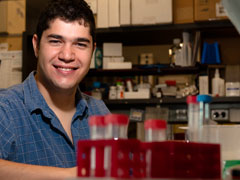Young, Bright and Honoured
By Jim Oldfield
Aruz Mesci couldn't ignore the e-mail that popped into his inbox one evening in April, which told him results of the Canada Graduate Scholarship (CGS) competition were ready.
With an unsteady hand, considerable apprehension and his supervisor at his shoulder, Mesci navigated to the online awards page to find out if he would receive a scholarship—or nothing.
Having landed in the bottom 25% in last year's competition, Mesci, a molecular and cellular biology student at Sunnybrook Research Institute (SRI) in the lab of scientist Dr. James Carlyle, had modest expectations. But the allure of the CGS, and the new Vanier awards—launched this year by the federal government, rivalling the Rhodes scholarship in the U.K. and the Fulbright scholarship in the U.S.—had kindled his hopes for months.
The results were good.
Mesci placed in the top 2% of the doctoral research category for his project, "The role of NKR-P1B:Clr-b missing-self axis in NK cell-mediated innate immunity to infection." The payoff was a Vanier award worth $150,000 over three years.
"I was ecstatic," he says. "It's almost like winning a lottery."
Sunnybrook Research Institute had a banner showing in this inaugural round of Vanier scholarships. In addition to Mesci's award, Rachel Chan, a student in the imaging lab of senior scientist Dr. Donald Plewes, was awarded $100,000 over two years, and Graeme Schwindt, a clinical integrative biology student with brain sciences research program director Dr. Sandra Black, took $150,000 over three years.
The Vanier awards were meted out to 166 recipients across the country this spring through the "tricouncil" federal granting agencies: the Canadian Institutes of Health Research, the Natural Sciences and Engineering Research Council, and the Social Sciences and Humanities Research Council. The program, which when fully operational will grant 500 scholarships annually, rewards students for their academic achievement and for showing leadership skills.
Schwindt's project, "Functional and structural brain imaging in Alzheimer's disease: Towards a biomarker of treatment response and decline," placed first of 673 applications in the clinical research category. "Functional magnetic resonance imaging (fMRI)," says Scwindt's supervisor Black, "has shown potential in identifying brain signals that are unique to Alzheimer's disease patients and may track disease progression, but results to date have been inconsistent." Schwindt's project takes a novel approach, says Black, "by focusing on a brain region that is not well-studied, but is affected early in the course of the disease and may predict a patient's change over time."
Chan also works with MRI, but for application in breast cancer. "Current screening protocol for high-risk patients using MR sometimes involves two separate scans, and it's not very specific," says Chan. "The goal of my project is to combine these two scans into one, and to improve specificity of diagnosis." That will require, she says, programming the MR scanner to collect data more efficiently, and "parallel imaging," a technique based on new hardware that speeds data collection. Chan's project is titled, "Flexible adaptive MRI for improved diagnosis of breast cancer."
Mesci and Schwindt attended an awards ceremony on April 30 in Ottawa at the Fairmont Chateau with Minister of State (Science and Technology) Gary Goodyear, where they heard talks from Vanier recipients on influenza and pneumonia, and the Inuit response to climate change, among others.
Chan didn't attend the event, but had the distinction of receiving her award notice the old-fashioned way: Canada Post. She read the news in her kitchen, which was, she says, "a pleasant surprise."
PDF / View full media release »





